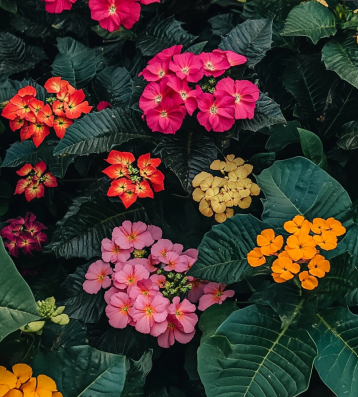Lantanas are hardy, vibrant plants that bring a splash of color to any garden. With their ability to thrive in different climates and minimal maintenance needs, lantana bushes are ideal for both novice and experienced gardeners. This guide will walk you through everything you need to know to grow beautiful, thriving lantanas that will add beauty and resilience to your garden year after year.
Why Choose Lantanas? 🌱
Lantanas not only produce stunning blooms in a variety of colors but also attract pollinators like butterflies and bees, enhancing the biodiversity of your garden. They’re drought-tolerant, resistant to pests, and can adapt to various soil types, making them a robust choice for gardeners.
1. Choosing the Right Location ☀️
Lantanas thrive in full sunlight and need at least six hours of sun daily. Choose a sunny, well-drained spot in your garden to prevent root rot and promote healthy growth. Avoid shaded or damp areas, as these can hinder their flowering potential.
2. Preparing the Soil 🌿
Soil preparation is essential for lantanas:
- Mix soil with organic matter like compost to improve drainage and add nutrients.
- Aim for a slightly acidic to neutral pH (6.0 to 7.5) for optimal growth.
Pro Tip: Well-drained soil is key, as lantanas are prone to root rot in soggy conditions. Raised beds or mounds can help in areas with poor drainage.
3. Planting Lantana Bushes 🌸
When planting lantanas, follow these steps for success:
- Dig a hole twice as wide and just as deep as the root ball.
- Place the plant in the hole, ensuring the top of the root ball is level with the soil surface.
- Fill the hole with soil and water thoroughly.
- Space plants 2 to 4 feet apart to allow for growth.
Spacing Tip: Proper spacing helps improve airflow, reducing the risk of diseases.
4. Watering Needs 💧
While lantanas are drought-tolerant once established, they need regular watering initially:
- Water newly planted lantanas frequently to help them establish strong roots.
- Once mature, water deeply but infrequently. Let the soil dry out between waterings to avoid overwatering.
Watering Tip: Water at the base of the plant to keep foliage dry and prevent fungal diseases.
5. Pruning and Maintenance ✂️
Pruning helps keep lantanas healthy and blooming:
- Trim back one-third of the plant in early spring before new growth begins.
- Deadhead spent flowers throughout the season to encourage continuous blooming.
Pruning Tip: Regular pruning keeps lantanas compact and promotes more blooms!
6. Fertilizing 🌻
Lantanas are low-maintenance with feeding:
- Use a balanced, slow-release fertilizer in the spring to provide nutrients.
- Avoid excessive fertilizing, as too much can lead to leafy growth at the expense of flowers.
7. Pest and Disease Management 🐛
Lantanas are resistant to many pests, but occasionally, aphids and whiteflies may appear:
- Inspect plants regularly for any signs of pests.
- Treat infestations with insecticidal soap or neem oil if necessary.
- Ensure proper spacing and airflow to reduce the risk of fungal diseases.
Conclusion: Bring Color and Life to Your Garden 🌷
Lantanas are an excellent choice for a resilient and vibrant garden. By following these simple steps, you can grow healthy lantana bushes that bloom beautifully and attract pollinators. With the right care, these bushes will flourish, bringing color and a touch of nature’s elegance to your outdoor space.
Ready to transform your garden with lantanas? Start with these steps, and enjoy the rewards of a thriving, low-maintenance garden!




